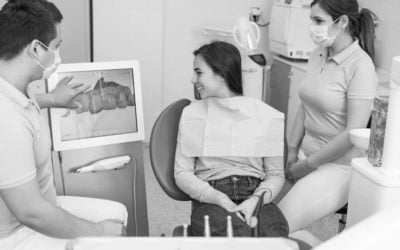Do you find yourself clenching and grinding your teeth? It could very well be signs of Temporomandibular Joint Dysfunction (TMD).

What is TMD?
Temporomandibular disorder affects 30% of adults at some stage during their lives. It refers to problems that affect your jaw and the muscles in your face controlling it.
Confusion between TMD and TMJ
You may have heard of the TMJ (temporomandibular joint), and when people suffer from jaw-related pain, they often mistakenly say that they are suffering from TMJ which actually refers to the joint between your lower jaw and the side of your head. You have one on each side of your head, made up of muscles, bones and cartilage.
Poorly aligned teeth can also be the cause of pain in your temporomandibular joint – read more about orthodontic treatment at Shields here.
What causes TMD?
There are a number of causes surrounding TMD complications which include:
- Clenching your jaw when you sleep, placing unwanted pressure on your joint.
- Damage or injury to your joint.
- Uneven bite as a result of dentures, crowns or fillings being fitted.
- (Less common) Disease such as gout, rheumatoid arthritis and fibromyalgia.

Clenching and grinding complications
Worn areas of your teeth or sore muscles when under assessment can be evidence of an incorrect bite. Grinding and clenching teeth causes wear, decay and sensitivity overtime, which can manifest into TMD and permanent jaw pain.
Your orthodontist here at Shields may prescribe you a hard plastic appliance called an Occlusal Splint, designed to fit over your upper and lower teeth. Occlusal Splints are custom made and provide diagnostic information as well as treatment, repositioning your condyles and relaxing your jaw muscles so that your teeth meet at the same time and in the correct way. The splint offers a platform for your teeth which in turn reduces the stress on your joint. After a period of wearing your Occlusal Splint, your orthodontist will asses whether your bite needs permanent correction. Most TMD complications can be resolved with non-surgical treatments.
Permanent treatment options for grinding and clenching
Tooth adjustment – The positioning and direction of the slopes guiding your teeth can be a way to reposition the jaw.
Replacing teeth – If you have a missing tooth this can be replaced using either dentures, implants or bridges – it is paramount that your TMJ has equal support on both sides of your jaw.
How do I know if I have TMD or Grinding and Clenching problems?
Symptoms related to TMD include:
- Pain in the muscles surrounding the jaw.
- Tightness in the jaw that causes difficulty with opening your mouth.
- Headaches and migraines.
- Loosened teeth and receding gums.
- Spasms in your jaw muscles.
- Tenderness when your teeth meet to bite (also known as ‘malocclusion’ – ‘occlusion’ refers to the way teeth meet when your jaw bites).
- Pain around your ears that might spread to the temple and cheek area.
- Clicking sounds when you move your mouth and chew.
Professional treatment at Shields
Shields can offer several permanent treatment options once you have been diagnosed. Our two orthodontists Conor and Cormac have extensive experience in treating and assessing grinding and clenching problems, having both trained with the British Society of Occlusal Studies.
If you would like to arrange a consultation to talk about possible TMD complications, please do not hesitate to contact us. Watch this space for our blog about ‘TMD – Jargon Buster’ where you can learn more about the terminology surrounding TMD in layman’s terms.







